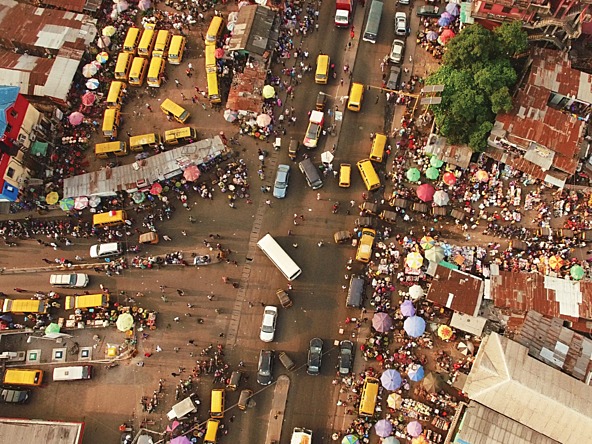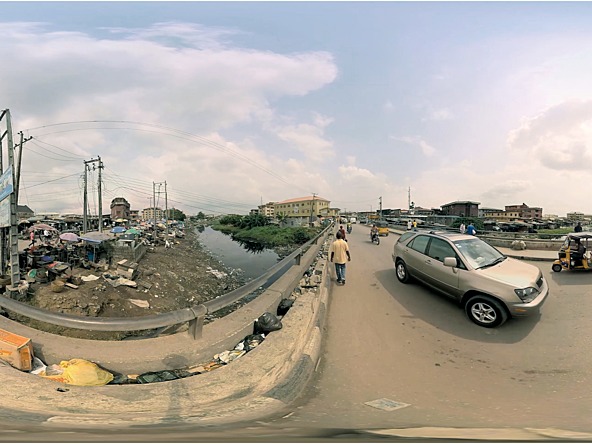FEATURE8 January 2018
Alternative view of Lagos life
x Sponsored content on Research Live and in Impact magazine is editorially independent.
Find out more about advertising and sponsorship.
FEATURE8 January 2018
x Sponsored content on Research Live and in Impact magazine is editorially independent.
Find out more about advertising and sponsorship.
To understand people’s daily lives in Lagos, Nigeria, Naked Eye used drones and virtual reality to give its pharmaceutical client a unique perspective on its research, explains Nick Leon.

With more than 20 million inhabitants, Lagos is the largest city in Africa. It has energy like no other place – loud, brash, sprawling and densely populated, it is traffic choked and polluted, with an intimidating crime rate and maxed-out public utilities. This is the city where our research participants lived.
Our job was to understand, for a global pharmaceutical company, how people managed flu and fever – from going to herbalists in outdoor markets, to using messaging apps on smartphones.
The people in Lagos work long, hard hours. Many have their own business and, to beat traffic, leave home in the early hours of the morning. Throughout the day they face heat, dust and pollution – all of which take a toll on their immune systems. From their neighbourhoods on the mainland to the roads that lead to the islands, navigating the city is part of the daily grind. Participants explained that the entire ebb and flow of the city seems to revolve around the traffic.
To help us make sense of their day-to-day lives, we wanted to map their daily commute to and from work. So, an ethnographer and a film-maker from UK-based Naked Eye travelled to Lagos and teamed up with local researchers, who helped run the interviews.
The researchers captured some information on the ground, using photography and film, but were constrained by security issues and the scale and density of crowds, cars and general commotion.
To gain a different perspective, we set up observations in the air, using drones. With the help of a licensed drone pilot, we were able to film from the sky and gain incredible visuals of the spaces through which our participants moved, and where they worked, shopped and spent time. From the mainland to the island, we mapped their routes.
Once we had downloaded the visuals, we were able to compare neighbourhoods. We shared the drone footage with the participants and they were fascinated. Drone footage gave us new ways of talking to participants about the spaces that surround them at home, and to and from work. They began to tell us stories of what had happened in these different places, and pointed out things from the aerial shots that were previously hidden from sight.
For example, the respiratory issues they suffered because of the dust thrown up from the dirt roads; drainage ditches that became breeding grounds for malaria in the rainy season; the lack of play space children had in their neighbourhoods; the state and repair of homes; where people congregated at weekends; the places they marked as no-go areas after dark; and the distance from their homes to pharmacies, clinics and stores. When it came to editing together the ethnographic films, the drone footage really gave the stories visual impact.

Many of our client team hadn’t been to Lagos, so we used virtual reality (VR) to evoke a deeper sense of curiosity about the places and lives of the participants. During the ethnography, we brought VR headgear with us, so we could create films that would allow the client to step into their world and give them a preview of what they were about to see in the ethnography.
This type of immersive film-making enabled clients to go on 360-degree home tours, and to visit stores to see what local pharmacies looked like. They could stand alongside street hawkers selling competing local brands and transport themselves to mock consultations taking place in real clinics.
These recent technologies are exciting research tools for ethnographers. VR, for example, allows us to move viewers away from simply ‘watching’, to ‘feeling’ and actively experiencing video content. VR, and even some of the drone footage, adds a layer of engagement with clients that moves them in a deeper way than description and reporting alone.
For clients that want to explore for themselves the world of consumers – particularly those who live in remote or distant locations – VR offers an exciting opportunity to do just that. Done correctly, it brings the world of the consumer right into the heart of the business, and creates more emotional connections and memorable learning experiences.
Nick Leon is founder of Naked Eye Research.
0 Comments